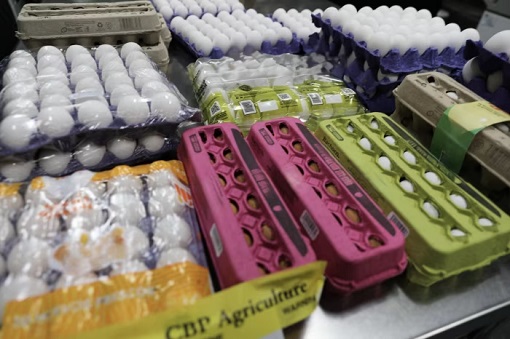Outsmarting Trump’s 145% Tariff – From Diverting China-US Imports To Canada To Smuggling In Black Market
May 6th, 2025 by financetwitter
China and Canada might have their own mini trade war going on, where Beijing slapped a 100% tariff on Canadian canola oil, oil cakes and pea imports, and a 25% duty on aquatic products and pork effective March 20, 2025. It was in retaliation for Canadian 100% tariffs on Chinese electric vehicles (EVs) and 25% surtax on Chinese steel and aluminium products – introduced in October 2024.
The Chinese retaliatory tariffs will impact over US$2.6 billion of Canadian agriculture and food products. But at the same time, both nations have a common enemy – United States. So, when U.S. President Donald Trump started targeting China with tariffs as high as 245%, Beijing simply slashed purchases of American crude oil by 90% and turned to Canadian oil.

It was a huge revenue loss for the U.S. when Chinese imports of U.S. oil collapsed to just 3-million barrels a month (March 2025) from a peak of 29-million (June 2024). The amount of Chinese oil imports from North America may be small compared to those from Russia and the Middle East. But Canada’s oil sands are cheap, dense, high-sulphur grades of crude that Chinese most-advanced refineries are equipped to process.

At the same time, the U.S. beef and pork exports to China have stopped thanks to the Chinese retaliatory tariffs on the American farm products ranging from 147% to 172%. To make matters worse, the export licenses for U.S. beef exporters which expired in March this year have not been renewed. While Trump had reversed his 145% tariffs on mobile phones and computers, this has not been reciprocated by Beijing.
In fact, China – in anticipation of a Trade War 2.0 – has not placed an order for American corn and soybeans since January 16, four days before the inauguration of US President Donald Trump. Not only Beijing suspended the soybean import license of three U.S. firms as early as March, but also had halted imports of U.S. logs. This is as good as cutting all imports of U.S. agriculture products.
But while U.S. crude oil, beef, pork, soybean, wheat and corn cannot enter China at all, the same cannot be said about Chinese products facing a whopping 145% tariffs trying to enter the U.S. market. The best part is it was the desperate U.S. importers who are snatching warehouses in Canada to store freight from China and temporarily avoid paying hefty tariffs on the goods.

Yes, amid the U.S.-China trade war, American business owners have re-routed Chinese goods to neighbouring Canada – and stored temporarily – in the hopes the levies are significantly eased before those products enter the US. As much as 50% of consignments from China were diverted to Canada in mid-April as many industries look to stockpile their inventory north of the border instead of in the U.S.
Third-party sellers for companies such as Amazon and Walmart have also begun to hoard goods in Canada so that their items may be held in a country where they won’t face any immediate payment of duties. This has caused warehouse storage reaches its capacity, which would benefit Canadian consumers due to an abundance of discount goods.
Flexport, a platform that co-ordinates global logistics, reported a 50% spike in consignments from China to Canada in just one week in mid-April. Customs brokers and other industry specialists are also seeing a surge in consumer packaged goods, chemical and automotive supply companies rushing to hoard inventory in Canada – ready to enter the U.S. market.

Obviously, the long term strategy of these companies is to outlast the Trump’s tariffs, which could drop to 50% (or even lower) from as high as 145%, while storing their products in the backyard of the U.S. and wait for the next action. Known for making U-turns and flip-flopping, American importers simply have no idea when Trump will change his mind or drop his tariffs.
But there’s one thing for sure – the 145% tariffs imposed on China will not go any higher, as announced by the U.S. president himself, because it has backfired as trades have stopped and shipments between both nations have abruptly halted. Because imported items can be held without immediate payment of duties, the simplest tactic is to store goods in Canadian warehouses.
However, the cost to store goods in a bonded warehouse could be higher than the cost of the tariff if the storage time is too long. In such case, the importers would most likely sell their goods into the Canadian market at steep discounts. Typically, it could cost sellers between US$200 and US$250 a day per container – an additional US$1,750 a week in storage costs.

The gambling is worthwhile. Empty shelves would soon hit American stores, which will force Trump to surrender. Chinese shipments to U.S. ports have dropped noticeably at the Port of Los Angeles, which, along with the Port of Long Beach, receives 40% of all imports from Asia. Port of Los Angeles executive director Gene Seroka said on April 24 – “It’s my prediction that in two weeks time, arrivals will drop by 35%.”
When Mr Trump, under pressure, is forced to drop or slash tariffs on China, the American importers would already have stockpiles of Chinese goods and can immediately send them across the border into America. Due to shortages, they could also increase the selling price to cover the cost of the warehousing and the tariffs, which U.S. consumers have no choice but to pay.
So, China is not the only one playing the game of chicken with the U.S., but also American business owners. Of course, if Trump doesn’t budge on his sweeping tariffs, the sudden influx of those diverted products from China could pose a threat to Canadian manufacturers. But the White House may face a new problem if Trump remains stubborn – goods flowing into American black markets.

If was only in March when U.S. Customs and Border Protection reported a 36% increase in interceptions as Americans travelled to Mexico and Canada for “egg smuggling” as prices in the U.S. surged to as high as US$10 a carton. So, what are the chances that smugglers won’t do the same with cash cows like toys, clothing, baby strollers, hair dryers and footwear?
Indeed, even Mafia bosses know that every economic decision that results in higher prices opens up a thriving smuggling market. Trump’s so-called “reciprocal tariffs” could see Mexican cartels, Italian criminal organisations, Russian mafia and other groups already capable of trafficking illegal items into the U.S. will now just as easily be able to smuggle legal ones.
Make no mistake – with the “U.S. embargo”, Chinese manufacturers will be trying to “sell things elsewhere in the world,” including Canada. Exactly how the products end up in the U.S. is not China’s problem, the same way fentanyl drug mysteriously enters the American soil from Mexico and Canada. Clearly, Trump’s tariffs are creating more problem than solution to the U.S. now that all bets are off.

In the long run, Canada could reap the benefits of becoming a hub for Chinese goods facing U.S. tariffs, but desperately needed by U.S. consumers. As the world’s largest consumer market, taking in roughly 15% of global imports last year, the U.S. is still a goldmine to exporters – and smugglers – eager to profit from the country that spent US$19 trillion in goods and service in 2023.
In the same breath, Canada warehouse isn’t the only option for Chinese products to enter the United States. Even though Southeast Asia nations are facing tariffs as high as 49%, it’s impossible to entirely clamp down on Chinese companies using countries like Vietnam, Cambodia and Malaysia as a transshipment hub or a back door to dodge U.S. duties.
Since the US-China trade war started in 2018, Vietnam has emerged as one of its biggest beneficiaries. Exports to the U.S. have soared, with the surplus hitting US$104 billion in 2023 – nearly triple the US$38 billion recorded in 2017. The U.S. suspected that Vietnam was used to relabel Chinese-made goods as Vietnamese before shipping them to the U.S., a tactic known as rerouting.

Even after Trump slapped a 46% tariff on Vietnam, it’s still extremely lucrative compared to China’s 145%. In theory, Beijing can stop direct shipments to the U.S., but indirectly diverts shipments elsewhere – to be stored in warehouses or undergoes re-labelling process – before ending up in the U.S. And there’s nothing the U.S. can do as China controls the global supply chain.
Wakakakaka...rabidly pro-China "Finance Twitter" basically confirming (and applauding) the massive fraud being carried out by China rebadging China products as "Made in Some Other Country", usually by just turning a few screwdrivers in a foreign land, with even the screws made in China.
ReplyDeleteMassive fraud being carried out by China?
DeleteMfer did u read carefully about who is importing Chinese goods into third party country & rebadging them as local?
Yr perennial China hatred has propelled yr fart to nth dimension!
What seems to be the story?
ReplyDeletehttps://x.com/dotconnectinga/status/1920458500775334336?s=19
BREAKING: Gates Foundation to spend $200 billion through 2045 when it will shut down
Today the Gates Foundation celebrates its 25th anniversary by announcing its plans to close up shop.
Established in 2000 — when Melinda French Gates was just 35 and Bill Gates was 44 and the world’s richest man — the foundation quickly became one of the most consequential philanthropies the world has ever seen, utterly reshaping the landscape of global public health, pouring more than $100 billion into causes starved for resources and helping save tens of millions of lives.
For all its pragmatic public-health spade work, the foundation has also served as a kind of valorous abstraction — the seeming embodiment of “the Golden Rule,” in a phrase that Bill Gates likes to use, and the face of an increasingly anachronistic era of elite optimism.